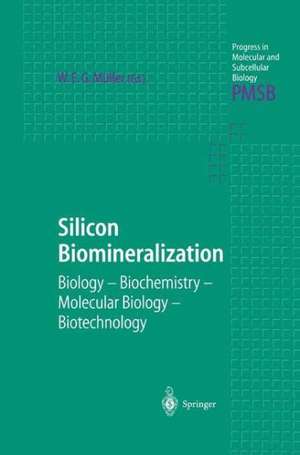Silicon Biomineralization: Biology — Biochemistry — Molecular Biology — Biotechnology: Progress in Molecular and Subcellular Biology, cartea 33
Editat de Werner E.G. Mülleren Limba Engleză Paperback – 17 aug 2012
In this monograph the role of biosilica as stabilizing structures in different organisms is reviewed and their role for morphogenetic processes is outlined. It provides an up-to-date summary of the mechanisms by which polymeric biosilica is formed. The volume is intended for biologists, biochemists and molecular biologists, involved in the understanding of structure formation in living organisms and will also be very useful for scientists working in the field of applied Nanotechnology and Nanobiotechnology.
| Toate formatele și edițiile | Preț | Express |
|---|---|---|
| Paperback (1) | 947.35 lei 6-8 săpt. | |
| Springer Berlin, Heidelberg – 17 aug 2012 | 947.35 lei 6-8 săpt. | |
| Hardback (1) | 956.81 lei 6-8 săpt. | |
| Springer Berlin, Heidelberg – 23 iul 2003 | 956.81 lei 6-8 săpt. |
Din seria Progress in Molecular and Subcellular Biology
- 18%
 Preț: 1115.46 lei
Preț: 1115.46 lei - 18%
 Preț: 1403.04 lei
Preț: 1403.04 lei - 18%
 Preț: 1112.30 lei
Preț: 1112.30 lei - 18%
 Preț: 1117.03 lei
Preț: 1117.03 lei - 18%
 Preț: 1222.49 lei
Preț: 1222.49 lei - 18%
 Preț: 1382.21 lei
Preț: 1382.21 lei - 18%
 Preț: 1232.26 lei
Preț: 1232.26 lei - 18%
 Preț: 1222.80 lei
Preț: 1222.80 lei - 24%
 Preț: 1045.91 lei
Preț: 1045.91 lei - 18%
 Preț: 956.50 lei
Preț: 956.50 lei -
 Preț: 387.20 lei
Preț: 387.20 lei - 15%
 Preț: 639.73 lei
Preț: 639.73 lei - 15%
 Preț: 633.19 lei
Preț: 633.19 lei - 15%
 Preț: 634.18 lei
Preț: 634.18 lei - 15%
 Preț: 634.00 lei
Preț: 634.00 lei - 15%
 Preț: 640.24 lei
Preț: 640.24 lei - 5%
 Preț: 714.27 lei
Preț: 714.27 lei - 15%
 Preț: 634.32 lei
Preț: 634.32 lei - 15%
 Preț: 637.28 lei
Preț: 637.28 lei - 15%
 Preț: 637.78 lei
Preț: 637.78 lei - 15%
 Preț: 637.28 lei
Preț: 637.28 lei - 15%
 Preț: 649.06 lei
Preț: 649.06 lei -
 Preț: 387.75 lei
Preț: 387.75 lei - 18%
 Preț: 1220.75 lei
Preț: 1220.75 lei - 18%
 Preț: 1224.99 lei
Preț: 1224.99 lei - 18%
 Preț: 946.87 lei
Preț: 946.87 lei - 15%
 Preț: 633.35 lei
Preț: 633.35 lei - 18%
 Preț: 944.36 lei
Preț: 944.36 lei -
 Preț: 387.96 lei
Preț: 387.96 lei - 15%
 Preț: 633.02 lei
Preț: 633.02 lei - 15%
 Preț: 640.88 lei
Preț: 640.88 lei - 5%
 Preț: 720.10 lei
Preț: 720.10 lei
Preț: 947.35 lei
Preț vechi: 1155.30 lei
-18% Nou
Puncte Express: 1421
Preț estimativ în valută:
181.29€ • 187.30$ • 150.80£
181.29€ • 187.30$ • 150.80£
Carte tipărită la comandă
Livrare economică 20 martie-03 aprilie
Preluare comenzi: 021 569.72.76
Specificații
ISBN-13: 9783642624513
ISBN-10: 3642624510
Pagini: 356
Ilustrații: XIII, 340 p.
Dimensiuni: 155 x 235 x 19 mm
Greutate: 0.5 kg
Ediția:Softcover reprint of the original 1st ed. 2003
Editura: Springer Berlin, Heidelberg
Colecția Springer
Seria Progress in Molecular and Subcellular Biology
Locul publicării:Berlin, Heidelberg, Germany
ISBN-10: 3642624510
Pagini: 356
Ilustrații: XIII, 340 p.
Dimensiuni: 155 x 235 x 19 mm
Greutate: 0.5 kg
Ediția:Softcover reprint of the original 1st ed. 2003
Editura: Springer Berlin, Heidelberg
Colecția Springer
Seria Progress in Molecular and Subcellular Biology
Locul publicării:Berlin, Heidelberg, Germany
Public țintă
ResearchCuprins
Organisms: Diatoms.- Living Inside a Glass Box-Silica in Diatoms.- Components and Control of Silicification in Diatoms.- The Phylogeny of the Diatoms.- Silicon-a Central Metabolite for Diatom Growth and Morphogenesis.- Organisms: Higher Plants.- Functions of Silicon in Higher Plants.- Silicon in Plants.- Organisms: Sponges.- Silica Deposition in Demosponges.- Molecular Mechanism of Spicule Formation in the Demosponge Suberites domuncula: Silicatein-Collagen-Myotrophin.- Biotechnology.- Biotechnological Advances in Biosilicification.- Silicase, an Enzyme Which Degrades Biogenous Amorphous Silica: Contribution to the Metabolism of Silica Deposition in the Demosponge Suberites domuncula.- Studies of Biosilicas; Structural Aspects, Chemical Principles, Model Studies and the Future.- Silicon Biomineralisation: Towards Mimicking Biogenic Silica Formation in Diatoms.- References.
Textul de pe ultima copertă
During evolution silica deposition has been used in Protozoa, Metazoa and in plants as skeletal elements. It appears that the mechanisms for the formation of biogenic silica have evolved independently in these three taxa. In Protozoa and plants biosilicification appears to be primarily driven by non-enzymatic processes and procedes on organic matrices. In contrast, in sponges (phylum Porifera) this process is mediated by enzymes; the initiation of this process is likewise dependent on organic matrices.
In this monograph the role of biosilica as stabilizing structures in different organisms is reviewed and their role for morphogenetic processes is outlined. It provides an up-to-date summary of the mechanisms by which polymeric biosilica is formed. The volume is intended for biologists, biochemists and molecular biologists, involved in the understanding of structure formation in living organisms and will also be very useful for scientists working in the field of applied Nanotechnology and Nanobiotechnology.
In this monograph the role of biosilica as stabilizing structures in different organisms is reviewed and their role for morphogenetic processes is outlined. It provides an up-to-date summary of the mechanisms by which polymeric biosilica is formed. The volume is intended for biologists, biochemists and molecular biologists, involved in the understanding of structure formation in living organisms and will also be very useful for scientists working in the field of applied Nanotechnology and Nanobiotechnology.
Caracteristici
Presents novel results in the rapidly growing field of basic and applied research in biomineralization and nanobiotechnology Authors are leading authorities in the field Includes supplementary material: sn.pub/extras















